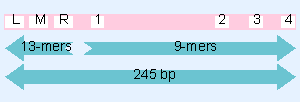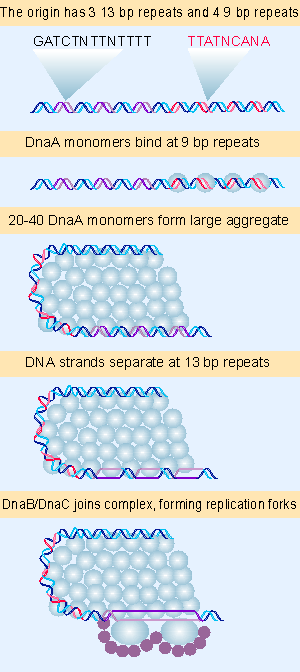12. Creating the replication forks at an origin
13.12 Creating the replication forks at an origin |
Starting a cycle of replication of duplex DNA requires several successive activities:
- The two strands of DNA must suffer their initial separation. This is in effect a melting reaction over a short region.
- An unwinding point begins to move along the DNA; this marks the generation of the replication fork, which continues to move during elongation.
- The first nucleotides of the new chain must be synthesized into the primer. This action is required once for the leading strand, but is repeated at the start of each Okazaki fragment on the lagging strand.
Some events that are required for initiation therefore occur uniquely at the origin; others recur with the initiation of each Okazaki fragment during the elongation phase.
Plasmids carrying the E. coli oriC sequence have been used to develop a cell-free system for replication from this origin. Initiation of replication at oriC in vitro starts with formation of a complex that requires six proteins: DnaA, DnaB, DnaC, HU, Gyrase, and SSB. The reaction converts a circular supercoiled template into a new form in which there is extensive unwinding of the duplex. Of the six proteins involved in prepriming, DnaA draws our attention as the only one uniquely involved in initiation vis-à-vis elongation. DnaB/DnaC provides the "engine" of initiation at the origin, as it does in the φX primosome.
 |
Figure 13.25 The minimal origin is defined by the distance between the outside members of the 13-mer and 9-mer repeats. |
 |
Figure 13.26 Prepriming involves formation of a complex by sequential association of proteins, leading to the separation of DNA strands. |
The first stage in complex formation is binding to oriC by DnaA protein. The reaction involves action at two types of sequences: 9 bp and 13 bp repeats. Together the 9 bp and 13 bp repeats define the limits of the 245 bp minimal origin, as indicated in Figure 13.25. An origin is activated by the sequence of events summarized in Figure 13.26, in which binding of DnaA is succeeded by association with the other proteins.
The four 9 bp consensus sequences on the right side of oriC provide the initial binding sites for DnaA. It binds cooperatively until 20 V40 monomers have formed a central core around which oriC DNA is wrapped.
Then the DnaA protein acts at three 13 bp tandem repeats located in the left side of oriC. The DNA strands are melted at each of these sites to form an open complex. All three 13 bp repeats must be opened for the reaction to proceed to the next stage.
The sequences of the 9 bp and 13 bp repeats are distinct, and we do not know whether they are recognized by the same or different binding sites on the DnaA protein. Both types of consensus sequences are A PT-rich.
 |
Figure 13.27 The complex at oriC can be detected by electron microscopy. Both complexes were visualized with antibodies against DnaB protein. Photographs kindly provided by Barbara Funnell. Multiple figure |
The DnaB and DnaC proteins form a complex in which 6 DnaC monomers bind each hexamer of DnaB. This generates a protein aggregate of 480 kD, corresponding to a sphere of radius 6 nm. The formation of a complex at oriC is detectable in the form of the large protein blob visualized in Figure 13.27.
The DnaB PDnaC complex transfers one hexamer of DnaB to form the replication fork. DnaB provides the helicase that unwinds the DNA. Probably it recognizes the single-stranded structure of the potential replication fork rather than the actual nucleotide sequence; at any event, it displaces DnaA from the 13 bp repeats and commences unwinding. DnaB functions in small amounts (1 V2 hexamers) at the origin. DnaB also has the same ability here to activate the DnaG primase that it has for the Okazaki fragments.
Two further proteins are required to support the unwinding reaction. Gyrase provides a swivel that allows one strand to rotate around the other (a reaction discussed in more detail in 14 Recombination and repair); without this reaction, unwinding would generate torsional strain in the DNA. The protein SSB stabilizes the single-stranded DNA as it is formed. The length of duplex DNA that usually is unwound to initiate replication is probably <60 bp.
The protein HU is a general DNA-binding protein in E. coli (see 17 Rearrangement of DNA). Its presence is not absolutely required to initiate replication in vitro, but it stimulates the reaction. HU has the capacity to bend DNA, and is likely to be involved in some general structural capacity.
Input of energy in the form of ATP is required for the prepriming reaction. It is required for unwinding DNA. The helicase action of DnaB depends on ATP hydrolysis; and the swivel action of gyrase requires ATP hydrolysis. ATP is also needed for the action of primase and to activate DNA polymerase III.
As the only member of the replication apparatus uniquely required at the origin, DnaA has attracted much attention. Some mutations in dnaA render replication asynchronous, suggesting that DnaA could be the "titrator" or "clock" that measures the number of origins relative to cell mass. Overproduction of DnaA yields conflicting results, varying from no effect to causing initiation to take place at reduced mass. However, there are no cyclic variations in DnaA concentration or expression, and current opinion has it that those cases in which dnaA affects cyclic control are probably due to indirect rather than direct effects.
What would be the properties of a mutation that altered the frequency of initiation? If initiation were caused by accumulation of an activator, a loss-of-function mutant should be in the slow-stop dna class, unable to start a new cycle. But if the regulator is an inhibitor, its loss should cause frequent cycles of initiation, perhaps leading to the accumulation of cells of reduced size. Such a mutant would not be found among the dna class, and would be more likely to appear among the potential segregation mutants (which we discussed in 12 The replicon). However, we have yet to identify the circuit that controls the frequency of initiation events.